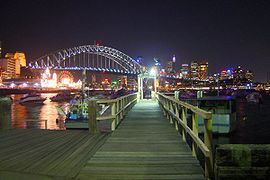Lavender Bay, New South Wales
|
Lavender Bay Sydney, New South Wales |
|||||||||||||
|---|---|---|---|---|---|---|---|---|---|---|---|---|---|

Lavender Bay Wharf
|
|||||||||||||
| Population | 852 (2011 census) | ||||||||||||
| • Density | 4,300/km2 (11,000/sq mi) | ||||||||||||
| Postcode(s) | 2060 | ||||||||||||
| Area | 0.2 km2 (0.1 sq mi) | ||||||||||||
| Location | 3 km (2 mi) north of Sydney CBD | ||||||||||||
| LGA(s) | North Sydney Council | ||||||||||||
| State electorate(s) | North Shore | ||||||||||||
| Federal Division(s) | North Sydney | ||||||||||||
|
|||||||||||||
Lavender Bay is a harbourside suburb on the lower North Shore of Sydney, New South Wales, Australia. Lavender Bay is located 3 kilometres north of the Sydney central business district, in the local government area of North Sydney Council.
The suburb takes its name from the natural feature of Lavender Bay, on Port Jackson (Sydney Harbour), to the west of the Sydney Harbour Bridge. It lies between Milsons Point and McMahons Point and the suburb of North Sydney is located, to the north. Lavender Bay is a residential suburb with expansive views of Sydney Harbour.
Lavender Bay was named after the Boatswain (bosun), George Lavender, from the prison hulk "Phoenix", which was moored there for many years. The bay was originally called Hulk Bay and sometimes Phoenix Bay. George Lavender lived on 14 acres (57,000 m2) adjacent to the property of Billy Blue. On 30 May 1915 Lavender Bay railway station was opened to take the place of Milsons Point railway station. This only lasted for seven weeks, as passengers refused to alight here and demanded that trains stop at Milsons Point. During the harbour bridge construction, Lavender Bay Station was the terminus for the North Shore Line. The area is now railway storage sidings.
Coordinates: 33°50′39″S 151°12′14″E / 33.84428°S 151.20388°E
...
Wikipedia
